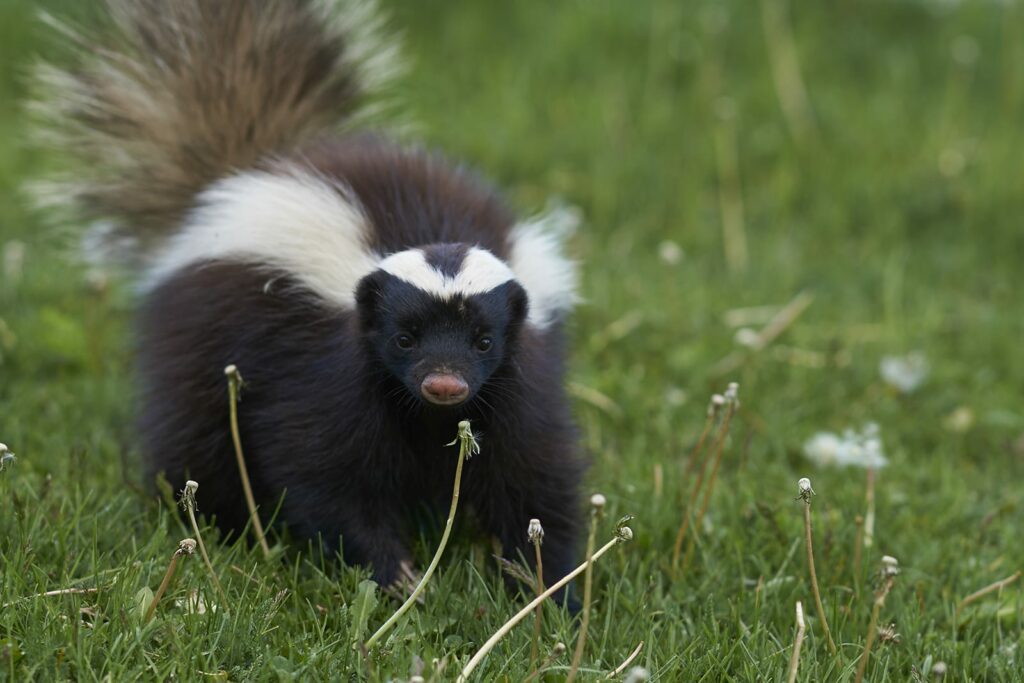
Contents

There is a very distinct smell that is unique to one type of pest, and you will know it immediately. Yes, it’s the smell of a skunk. You have every reason to be nervous when you suspect a skunk is in the area and even if you don’t smell it yet. Learn how to deal with a skunk when one may live in your neighborhood.
The most obvious sign of a skunk is indeed its smell. Skunks are best known for their defensive spray, which they often use when they are startled or confronted. Even though just the appearance of a skunk doesn’t strike fear, the threat of its stench is enough to be wary when around one.
What makes a skunk stink? Well, that defensive measure of spraying comes from two glands that are on either side of the skunk’s anus. The chemical that it emits is a thiol, or an organic compound with sulfur as one of its principal components. You might recognize the smell of sulfur by its similarity to the smell of rotten eggs. This extremely strong scent can even be smelled a half mile away, and can linger for days or even weeks.
Another reason to be cautious when near a skunk is its ability to aim and spray at targets that are 10 feet away. The spray can cause bad stinging of the eyes, nausea, or even temporary blindness. Because of this smell, most predators, like wolves or badgers, will rarely attack skunks. The skunk’s only regular predator is the Great Horned Owl.
If you do not yet smell a skunk, you can look for other signs that one could be near. Their tracks will show that they have fine, long, plump, clawed toes on each of its four feet. The pads on their front paws are smaller and rounder than the back paws, and their toes will be about as long as the paw pads themselves. You might find these tracks in gardens or dirt around your home and are easily visible in snow or mud.
The diet of a skunk comprises mostly subterranean foods, including grubs, worms and even roots. To get down into the dirt, skunks will dig small, cone-shaped holes that are around 3 to 5 inches in diameter. These holes will be wider near the surface, and will taper inward as the skunk digs deeper. However, the holes are relatively shallow, and you may spot over one in a proximity.
Finding skunk droppings is another clear sign one might be near. Their droppings are usually only 2 inches long, and smaller than a half inch in diameter. You may not think at first that they are skunk droppings, as they look very similar to cat droppings. Skunk droppings are found close to where they eat, and can contain food that is not completely digested, leaving grass, buts, or insect parts still intact.
It is wise that if you see a skunk, or suspect one is nearby, that you stay away and keep your pets away too. The smell of a skunk is extremely difficult to remove, and many home remedies fall short of 100 percent success. If you suspect a skunk might be present in your neighborhood, contact the pest control specialists at Van Den Berge Pest Control at 616-392-7367.
Trust the locally owned, widely renowned experts at Van Den Berge Pest Control for all of your pest needs. With over 100 years of combined experience throughout the Holland, MI-based pest control team, you know you’re in expert hands with our state-certified experts.
Recent Posts
Effective Flea Extermination for Your Pets
Just as a knight must armor up to battle a dragon, you need a solid
What Are Professional Flea Extermination Services?
If you’re dealing with a flea infestation, understanding professional flea extermination services is vital. These
Can You Really Keep Mice Out of Apartments?
Keeping mice out of apartments is more than just wishful thinking. By understanding their behavior
